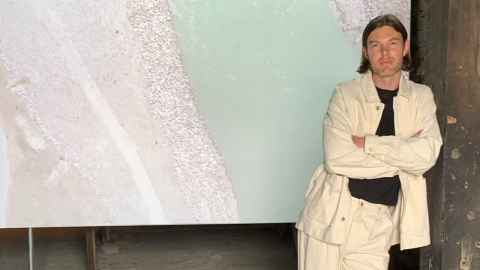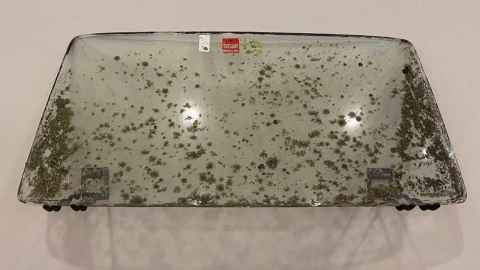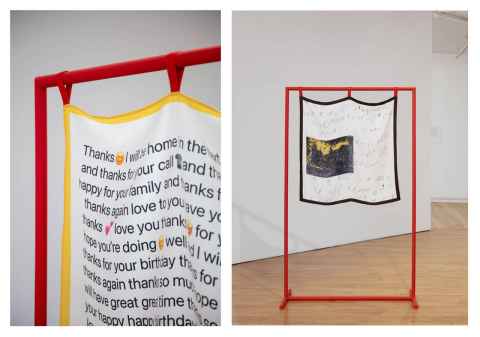A new exhibition delves into the concept of luck by drawing from the echoes of the past and the complexities of the digital age.

An artwork that's part of a new exhibition at Gus Fisher Gallery takes inspiration from New Zealand's failed attempt to curb petrol consumption and reduce car use in the late-1970s.
The petrol demand reduction scheme, known as 'Carless days', was implemented by the Muldoon-led National government during the 1979 oil crisis that was triggered by the Iranian Revolution.
With petrol prices soaring, the initiative required vehicle owners to designate a day of the week when they refrained from driving and affix a government-issued sticker to their windshield.
For his thought-provoking artwork, Elam School of Fine Arts doctoral student Matthew Galloway tracked down old car windshields, ephemera and other archival material to offer a captivating glimpse into the bygone era, while inviting viewers to contemplate the relevance of past events in shaping our present reality.
"I'm interested in how this moment of fuel shortage echoes into the present, perhaps acting as a premonition," he says.
The work is from Eight thousand layers of moments, a group exhibition exploring the idea of 'luck' that features doctoral students and alumni from Elam School of Fine Arts and the Academy of Fine Arts in Helsinki. It opens on 15 March at Gus Fisher Gallery in Auckland.
"There is a bigger theme at play in this work around the luck of global markets and geo-political moments such as the Iranian Revolution that might have seemed very removed from New Zealand but compounded to create a certain effect here - a fuel shortage and need for drastic action from the Government.
"Some might see that compounding of circumstance as bad luck. I like the idea that luck is so subjective that we choose what we feel is lucky or not, even when nearly everything can be explained by a set of consecutive moments leading toward an outcome."

Carless days ran from July 1979 to May 1980 and led to an estimated 3.5 percent drop in petrol consumption during the time.
Those in certain professions or who needed to use their vehicles on carless days could apply for a temporary exemption sticker. But imitation stickers produced on the black market weakened the effectiveness of the scheme, resulting in it being scrapped.
For the exhibit, Matthew worked with car wreckers and classic car restorers to locate windshields from the 1970s that had traces of old carless days stickers.
"I ended up finding some beautiful old windshields from models like the Ford Cortina and Toyota Corona, all of which were covered in moss. I love the way this speaks to the passage of time and the obsolete nature of the windshields, as well as the political thought and mandates of the time."
Matthew's doctoral research explores the intersection of art and design, and how human intervention shapes our environment. From urban green spaces to cityscapes, every element reflects deliberate design decisions rather than natural occurrences, he says.
"If we can see the world in this way, we can begin to critique the design decisions that have created our modern landscapes. We can use features of this landscape to understand our contemporary moment, as well as how the past has led us here, and what the future might look like."

Louise Menzies' work for the exhibition navigates the grey area between luck and chance, exploring how forces like machine learning have shaped our lives in the digital age.
The Elam doctoral student will include a collection of scarves in the exhibition that are infused with references to AI-generated text. Collaging fragments of language with incidental photos selected from her camera roll, these works merge the intimacies of both the digital and material worlds we occupy - the scarf and smartphone each as portable items that exist in proximity to the body.
"Forms of machine learning underpin much of our digital experience and can produce instances where things can seem either coincidental or convenient, which perhaps we might mistake for luck," she says.
Her evocative work highlights the woven threads of text and textile, drawing parallels between language as code and weaving's connection to early forms of computing.
"The works are both scarves someone might wear and framed images to observe. In the gallery they are presented as objects, displayed on a series of bright red wooden stands - as free-standing sculptures, almost human in size. I wanted to elevate their material nature, as something flat but capable of volume, as well as their function as clothing, as a piece of cloth that might comfort or conceal."
Her ongoing doctoral project explores the intersection between care work and artistic practice that emerged from her experience of the pandemic.
Eight thousand layers of moments runs from 15 March until 11 May at Gus Fisher Gallery and brings together thirteen artists from New Zealand and Finland. The group exhibition features current Elam doctoral students Matthew Galloway, Louise Menzies, Katrina Beekhuis, Yukari Kaihori, and Roma Anderson, alongside Elam alumni Paul Cullen and Sean Kerr, Associate Professor at Elam.
The exhibition is one element of a wider exchange between the artists, which includes an experimental publication un/luck and a reciprocal forthcoming exhibition in Helsinki.
The publication collects a series of responses to the question 'what is luck?'. Together, the artists consider luck and its connotations from a wide variety of artistic positions across cultures, geographies, and artistic practices, asking how aspects of chance, unpredictability, agency and control intersect with place, privilege, history and language. It will be launched on Saturday 4 May with a panel discussion at Gus Fisher Gallery.






